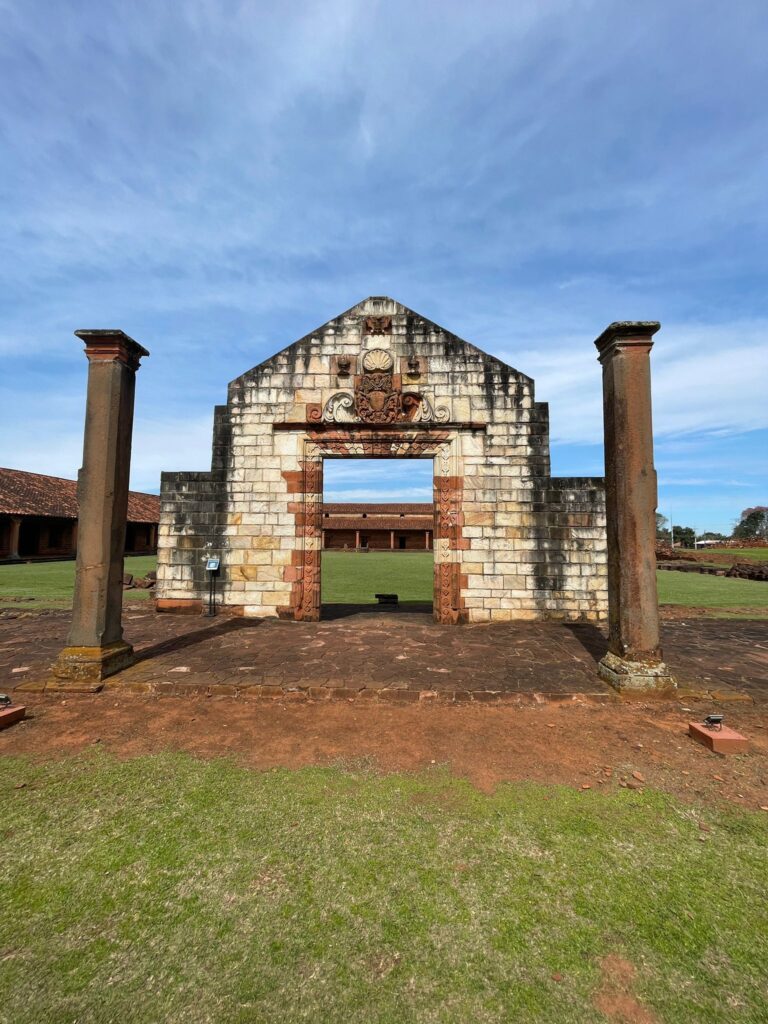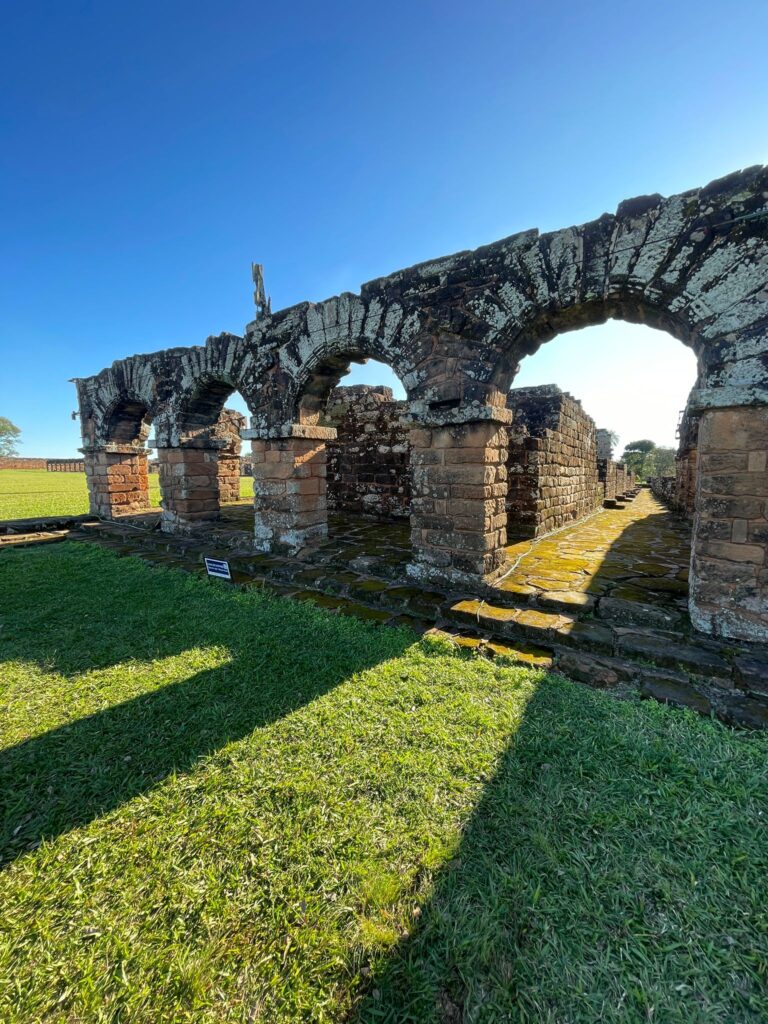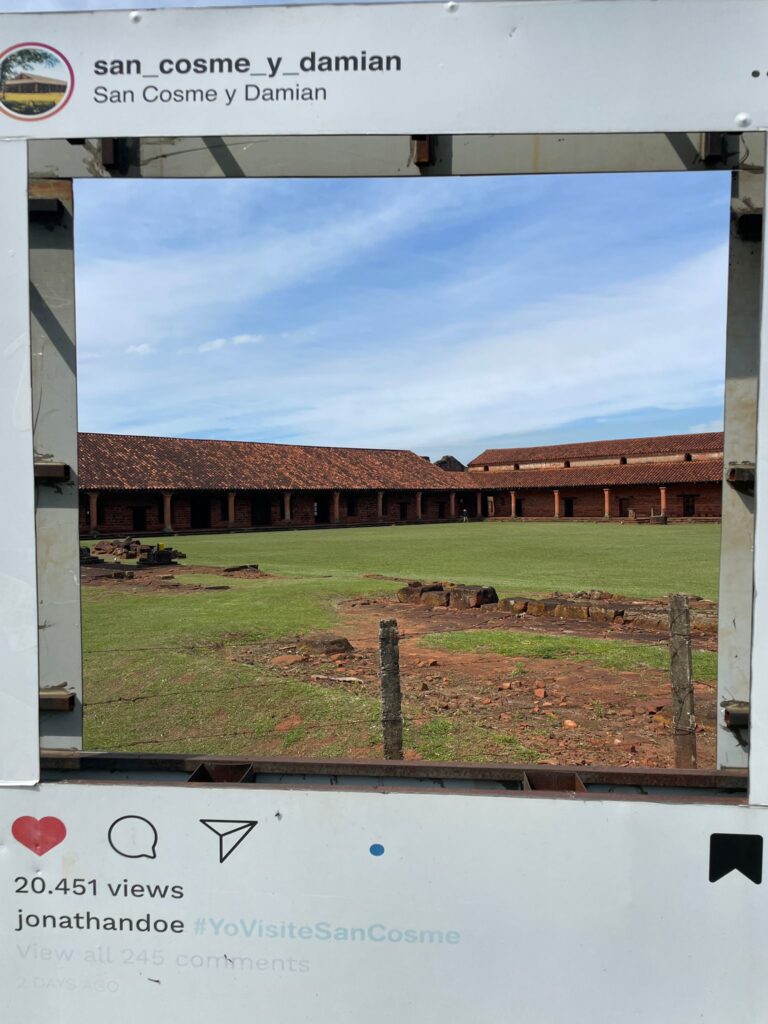Helpful Information on Visiting the Jesuit Missions in Paraguay
Disclaimer: Some links on this page may be affiliate links. If you purchase anything through them, I will receive a small commission at no extra cost to you! Further details in the Privacy Policy.
I visited the Jesuit Missions in Paraguay, and can now bring you all the information you need to do the same. I was almost stranded in the middle of nowhere, so read on to find out how you can avoid this pitfall.
I must admit that these Jesuit ruins aren’t quite as impressive as some of the other ruins you will be familiar with if you’ve travelled across the Americas and seen the likes of Guatemala’s incredible Mayan ruin site Tikal, or Peru’s world wonder Machu Picchu.
But they are one of the main attractions in humble Paraguay, a country I love for its amazing food and quieter destinations. Read on to find out how to visit them smoothly. They should be a must-visit if you have a week in Paraguay.

What are the Jesuit Missions in Paraguay?
Paraguay’s Jesuit missions are a series of ruins today. However once upon a time they were mini villages built by Jesuit missionaries alongside the Guarani locals during the Spanish colonial period.
The Jesuits helped the Guarani people develop a more advanced society, using the knowledge they brought over to Paraguay. At the same time, they influenced the Guarani natives with religious teachings, having earned their trust.
I learnt this information from local guides at some of the ruins. I would say having a Paraguayan girlfriend helped massively as the guides only speak Spanish, not English. Although you may not have language barrier issues if you’re fluent in the local Guarani language!
It is also worth noting that two of the Jesuit missions (La Santisima Trinidad de Parana and Jesus de Tavarangue) make up Paraguay’s only UNESCO World Heritage Site. This makes them an attractive place to visit for history lovers.
Let’s look into the ruins themselves and everything you need to know before visiting them.
La Santisima Trinidad de Parana
Where it is and how to get Here
The Santisima Trinidad de Parana mission is located 30km or a 38-minute drive from the city of Encarnacion on Paraguay’s southern border with Argentina. I would strongly recommend staying in Encarnacion to visit the ruins.
You can get a bus from this spot in Encarnacion to reach the ruins. There is a clearly visible bus stop on Avenida Caballero located between the roads Posadas and Tte. Roberto Baez.
From here, you should take any bus heading north with Ciudad del Este listed as its destination. The journey should take just over half an hour.
The bus costs 20,000 guaranies (£2/US$3) per person.
Make sure you get off the bus around here. And remember that spot, because you will need to head back there to take the bus to Encarnacion.
Bring cash to buy the bus ticket, as public transport here doesn’t use the card system favoured by Asuncion’s buses.
How Much Does Entry Cost?
Tickets cost 40,000 guaranies (£4/US$5) for foreigners and 25,000 (£2.50/US$3.25) for anyone with a Mercosur card (citizens of Paraguay, Uruguay, Argentina and Brazil). They are free for children under 12.
Tickets are valid for 3 days and cover all three major Jesuit missions: La Santisima Trinidad de Parana, Jesus de Tavarangue and San Cosme y Damian.
Opening Hours
The ruins are open from 8am-6pm in the summer and 8am-7:30pm in the winter. You can visit on any day of the week.
What you will Experience Here
You are supposed to be given a guide who will show you around the ruins for no extra cost. However we weren’t given one here and we weren’t aware this was the case until after we had left.
Make sure you ask for a guide if you aren’t assigned one, they will richen your experience with their knowledge of the missions and what occurred within them. Please note however, that they do not speak English. Make sure you either speak Spanish or go with someone who does for the best experience.
These 18th century ruins are better preserved than many others. There are a series of buildings remaining today, including a church, a main square and several other structures. There’s even a small crypt underneath, although I didn’t find it particularly interesting down there as you can’t go much further than the entrance, and it’s just made up of a few empty shelves.
The ruins are quite exposed if you come on a sunny day. And most days in Paraguay are sunny. Read my article on the best time to come to Paraguay for more information on that. Therefore bring sunglasses and sun cream, because there are only a small handful of shady spots here.

Jesus de Tavarangue
Where it is and how to get Here
Only 12km separate the two UNESCO-protected missions from each other, therefore you would think it would be easy to catch a bus between the two. Unfortunately, that isn’t the case.
From Santisima Trinidad de Parana, you will need to take a taxi. The cost of the taxi to Jesus de Tavarangue, around 45 minutes of waiting time and return to the bus stop needed when you head back to Encarnacion is 90,000 guaranies (£9/US$12).
This is enough time to see everything, so don’t worry about that.
I would advise doubling up your trip and visiting both missions together rather than making two trips from Encarnacion.
How Much Does Entry Cost?
Once again, it costs 40,000 guaranies (£4/US$5) for foreigners and 25,000 (£2.50/US$3.25) for Mercosur card holders, whilst remaining free for children under 12.
Your ticket from Santisima Trinidad de Parana is valid for all three missions. Therefore you won’t need to pay unless this is the first one you visit.
Opening Hours
Hours are the same here as for Santisima Trinidad de Parana. The mission is open from 8am-6pm in the summer and 8am-7:30pm in the winter from Monday-Sunday.
What you will Experience Here
You will receive your guide at the ticket booth, and he or she will take you straight into a dark room where you will watch a short video on the Jesuit missions. The video is in Spanish, but they do have English subtitles if you ask.
Your guide will then take you around the ruins themselves, which are similar to the others in some ways, as they show the remains of a once-functioning civilisation, this one dating back to the 17th century.
It will take little more than half an hour to experience everything.
They will even show you some trees where yerba mate grows. If you aren’t familiar with yerba mate, it’s a herbal drink with similarities to coffee and tea which is super popular in Paraguay and Argentina. Paraguayans prefer a cold version of the drink called terere, which is admittedly a bit of an acquired taste. I wasn’t a massive fan if I’m totally honest.
Once your tour is over, hop back in the taxi and go back to the bus stop. Then catch any passing bus with Encarnacion as its destination. Again, the journey should take little over half an hour.

San Cosme y Damian
Where it is and how to get Here
This is the trickiest of the three ruin sites to reach. It is an 87km distance or 3-hour bus journey from Encarnacion. You will need to go to Terminal de Omnibus de Encarnacion (the main bus terminal) and take a bus with San Cosmeña which leaves once a day at 8:30am.
Whilst the bus terminal has offices for many different companies, San Cosmeña does not have a presence and you will have to buy from a person selling tickets without any company branding. Sounds dodgy, but this is the only way, and I had no problems doing this. You just need to speak a little Spanish. “Un boleto a San Cosme y Damian por favor” is all you need to know. In English: “A ticket to San Cosme and Damian please”.
Getting back is the tricky part. There is one bus which comes at exactly 4pm. Since it takes under an hour to see everything, you will be hanging around for a while. There’s a small restaurant opposite the ticket office where you can kill time whilst waiting.
The bus is a school bus that can take tourists, but often requires prior notice. You should ask staff at the ruins to contact the bus operator, let them know you’re coming, and ask to catch the bus directly outside the ticket office for the ruins. This is what I did and it worked, otherwise I could have missed it given the fact multiple people gave me different directions for the bus stop.
You don’t want to be stranded in what is effectively a ghost town outside of the ruins and the small school. Paraguay is a safe country, but this place has no hotels and would be pretty spooky at night.
How Much Does Entry Cost?
Once again, entry costs 40,000 guaranies (£4/US$5) for foreigners, 25,000 (£2.50/US$3.25) for Mercosur card holders, and is free for children under 12. Your ticket from the other ruins is valid for all three sites over a period of three days.
Opening Hours
The ruins here are open daily from 7am-8pm. But don’t come late unless you have your own transport, because the 4pm bus is your only way out otherwise…
What you will Experience Here
This mission is split into two sections. Yes, there are ruins, but that’s not the only place your ticket allows access to.
There is an observatory by the main entrance which was once a very important place for astrologists. European scientists received data from here as they were keen on learning more about space from a southern hemisphere perspective.
You will be taken around the observatory by a Spanish-speaking guide. My guide was a very friendly chap who seemed quite knowledgeable. However I’m not yet fluent in Spanish and therefore struggled to understand everything he said.
He will show you a film on the observatory, then key instruments ranging from the old (sundials) to the new (telescopes) and some models of space.
Eventually he will pass you over to another guide who takes you across the road to the Jesuit ruins. These ruins are the only ones with a building that still functions, in this case a church. The church is made up of both original and restored materials, and even hosts occasional services.
Your guide will take you around for half an hour or so. There’s little to see outside of the church building.
Then you should have something to eat, as the bus times mean you will have a few spare hours here. There’s a small park between the observatory and ruins. Aside from that, chilling in La Mision Restaurant opposite the ticket office is just about the most interesting thing to do.

Are the Jesuit Missions Safe to Visit?
Yes. All three of them are in fairly remote areas. There are small populations living in each, but you do not have to worry about crime here. Outside of a few hotspots, Paraguay is one of Latin America’s safest countries.
The one thing to be aware of is stray dogs. There are a fair few roaming around outside the ruins, particularly in San Cosme y Damian. Carry a rock with you for safety, and pull your arm back as if you’re going to throw it if an aggressive dog gets too close. This will scare them into backing off.
Whilst crazy traffic can be a safety issue in Paraguay, that isn’t so much the case near the Jesuit missions due to their remote locations with only a handful of vehicles passing through.
Where Should I go Next?
After the ruins, you will most likely be heading back to Encarnacion. The beach aside, I didn’t find Encarnacion had a lot to offer. However there are plenty of other places in Paraguay worth visiting.
You can even cross the border into Posadas, an Argentinian city just south of the Parana River. But I’d recommend a few more stops in Paraguay first. as it deserves to be part of your South America itinerary.
The capital Asuncion has many fun things to do. You can see the president’s palace, learn about Paraguayan culture, or just use it as a base to fly elsewhere. Being the capital, it is also home to the liveliest airport in the country.
There are two awesome places to visit just over an hour from the capital. One is Aregua on the banks of Lake Ypacarai. This small city is famous for strawberries and ceramic goods, which attract visitors from all across the country.
There is also the amazing holiday resort of San Bernardino where you can chill on the beach, eat amazing steak from O Gaucho, an all-you-can-eat steakhouse in the area, or party if that’s what you’d rather do.
Whilst these places are all to the west of Encarnacion, you could instead head east to the border city of Ciudad del Este. This is home to the iconic Saltos del Monday waterfall, which is overshadowed by Iguazu Falls just across the border in Argentina and Brazil. You can also check out Itaipu Dam which straddles the border with Brazil. You will need to read my guide on the tricky Triple Frontier border region first however.
Or if you’re feeling really adventurous, head up north to the vast Chaco region which is home to many indigenous peoples and lots of wildlife.
Paraguay is a hidden gem which is well worth visiting.
More Posts on Paraguay
- The 17 Best Cities In South America To Visit In 2025
- The Safest Countries In South America In 2025: Ranked
- Best Countries In South America To Travel To: Ranked
- The 15 Most Underrated Countries To Visit In 2025
- What Are The Best South American Countries For First Timers?
- What Are The 10 Safest Cities In South America In 2025?
- The Ultimate 6 Month South America Itinerary On A Budget
- Salta To Asuncion By Bus (Clorinda/Jose Falcon Border)
- 7 Day Paraguay Itinerary: From Asuncion To Ciudad Del Este
- Iguazu Falls Border Crossing: How To Cross The Triple Frontier Between Argentina, Brazil And Paraguay
- 6 Best Restaurants In Asuncion Paraguay: All-You-Can-Eat Delights
- Helpful Information On Visiting The Jesuit Missions In Paraguay
- 19 Best Things To Do In Asuncion, Paraguay
- Is Paraguay Worth Visiting? South America’s Hidden Gem
- Is Paraguay Safe For Tourists To Visit?
- When Is The Best Time To Visit Paraguay?
- Everything You Should Know Before Visiting San Bernardino, Paraguay
- Visiting Aregua In Paraguay: The Home Of The Strawberry Expo
- Bus Transport In Asuncion: How To Get Around Paraguay’s Capital
- Safest Latin American Countries To Visit In 2025
